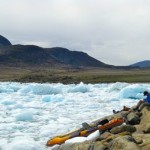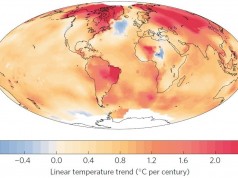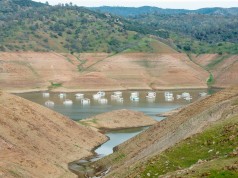
Greenhouse gases emitted today will cause sea level to rise for centuries to come. Each degree of global warming is likely to raise sea level by more than 2 meters in the future, a study now published in the Proceedings of the National Academy of Sciences shows. While thermal expansion of the ocean and melting mountain glaciers are the most important factors causing sea-level change today, the Greenland and Antarctic ice sheets will be the dominant contributors within the next two millennia, according to the findings. Half of that rise might come from ice loss in Antarctica which is currently contributing less than 10 percent to global sea level rise.
“CO2, once emitted by burning fossil fuels, stays an awful long time in the atmosphere,” says Anders Levermann, lead author of the study and research domain co-chair at the Potsdam Institute for Climate Impact Research (PIK). “Consequently, the warming it causes also persists.” The oceans and ice sheets are slow in responding, simply because of their enormous mass, which is why observed sea level rise is now measured in millimeters per year. “The problem is: once heated out of balance, they simply don’t stop,” says Levermann. “We’re confident that our estimate is robust because of the combination of physics and data that we use.”
The study is the first to combine evidence from early Earth’s climate history with comprehensive computer simulations using physical models of all four major contributors to long-term global sea level rise. During the 20th century, sea level rose by about 0.2 meters, and it is projected to rise by significantly less than two meters by 2100 even for the strongest scenarios considered. At the same time, past climate records, which average sea level and temperature changes over a long time, suggest much higher sea levels during periods of Earth history that were warmer than present.
For the study now published, the international team of scientists used data from sediments from the bottom of the sea and ancient raised shorelines found on various coastlines around the world. All the models are based on fundamental physical laws.
“The Antarctic computer simulations were able to simulate the past five million years of ice history, and the other two ice models were directly calibrated against observational data – which in combination makes the scientists confident that these models are correctly estimating the future evolution of long-term sea level rise,” says Peter Clark, a paleo-climatologist at Oregon State University and co-author on the study. While it remains a challenge to simulate rapid ice loss from Greenland and Antarctica, the models are able to capture ice loss that occurs on long time scales where a lot of the small rapid motion averages out.
If global mean temperature rises by 4 degrees compared to pre-industrial times, which in a business-as-usual scenario is projected to happen within less than a century, the Antarctic ice sheet will contribute about 50 percent of sea level rise over the next two millennia. Greenland will add another 25 percent to the total sea level rise, while the thermal expansion of the oceans’ water, currently the largest component of sea level rise, will contribute about 20 percent, and the contribution from mountain glaciers will decline to less than 5 percent, mostly because many of them will shrink to a minimum.
“Continuous sea level rise is something we cannot avoid unless global temperatures go down again,” concludes Levermann. “Thus, we can be absolutely certain that we need to adapt. Sea level rise might be slow on time scales on which we elect governments, but it is inevitable and therefore highly relevant for almost everything we build along our coastlines, for many generations to come.”
Details of the Study:
Title of the Study: “The Multimillennial Sea-Level Commitment of Global Warming”
Authors: Anders Levermann, Peter U. Clark, Ben Marzeion, Glenn A. Milne, David Pollard, Valentina Radic and Alexander Robinson
Published in Proceedings of the National Academy of Sciences (early online edition); DOI: 10.1073/pnas.1219414110
Check the following link to read/download the Full Study:
http://www.pnas.org/content/early/2013/07/10/1219414110.abstract
Source: PIK.















[…] international team of scientists led by Anders Levermann recently published a study that found for every degree Fahrenheit of global warming due to carbon pollution, global average […]